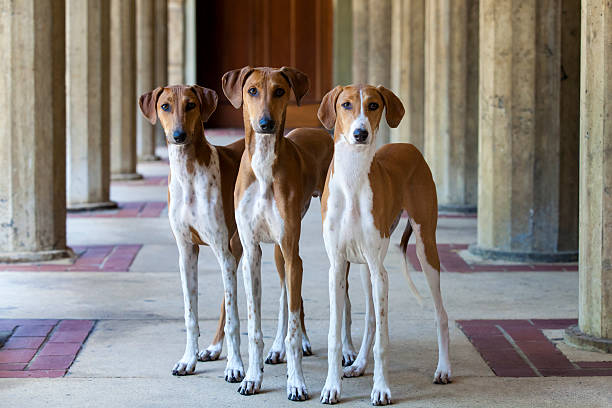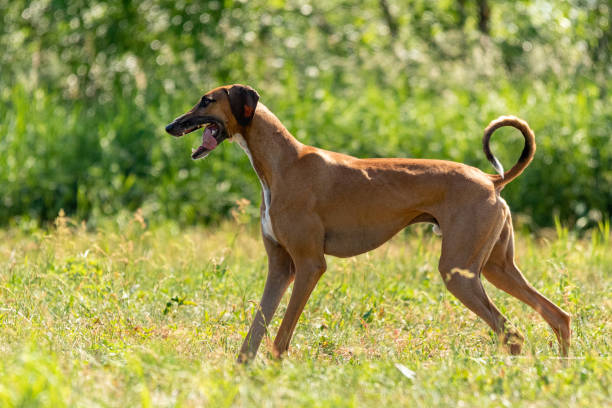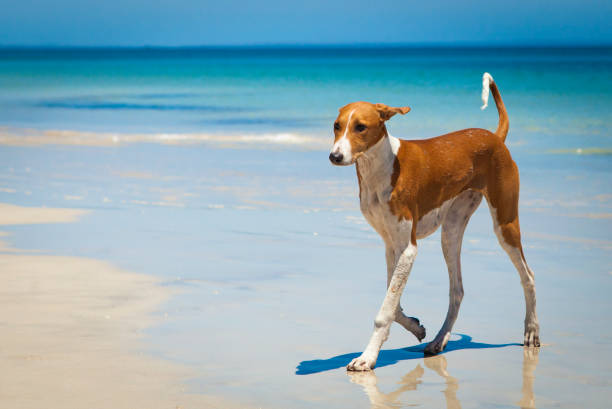Azawakh
Breed History:
The Azawakh is a rare and elegant sighthound that originates from the Sahel region of West Africa, particularly countries like Mali, Niger, and Burkina Faso. Traditionally bred by nomadic Tuareg and other pastoral tribes, the Azawakh served as a guardian and hunter, protecting flocks and chasing down game such as gazelles and hares across vast desert landscapes. Its history spans centuries, deeply embedded in Saharan culture where it is valued not just as a working dog, but as a companion and symbol of status.
Renowned for its speed, stamina, and independence, the Azawakh has adapted to some of the harshest environments on earth. Unlike many other breeds, it has been shaped more by natural selection than controlled breeding, making it highly resilient. Despite its lean, almost fragile appearance, the Azawakh is hardy and strong, capable of withstanding intense heat and long periods of exertion. Loyal and affectionate with its family, it remains aloof and watchful around strangers—a trait that underscores its guarding heritage.
|
Gender |
Height |
Weight |
|
Male |
64–74 cm |
20–25 kg |
|
Female |
60–70 cm |
15–20 kg |
Size – Medium
Life Expectancy: 12–15 years

Breed Appearance:
The Azawakh is a strikingly slender and athletic breed, characterised by its long legs, deep chest, and visible musculature beneath a fine, short coat. Its narrow body and elegant lines are not only aesthetic but also functional, enabling swift, agile movement across difficult terrain. The breed’s skin is thin and tight, with minimal fat—an adaptation to its hot native climate.
It has a refined, chiselled head with almond-shaped eyes that convey alertness and dignity. Its ears are set high and drop loosely to the sides, while the tail is long and tapering, often carried low. The coat comes in various shades, including fawn, red, sand, and brindle, often with white markings. Due to its sparse fur and low body fat, the Azawakh is highly sensitive to cold temperatures and requires care in cooler environments.
Breed Type - Family/guard:
Though bred for both hunting and guarding, the Azawakh functions more as a companion and alert watchdog in modern homes. It is deeply loyal and bonds closely with its human family but tends to be reserved—even distant—with strangers. Protective but not aggressive, the Azawakh will observe and alert rather than confront, unless provoked or sensing danger.
This breed does best with experienced owners who understand its independent temperament and need for respectful handling. It is not typically suited for chaotic or overly busy households, as it thrives in calm, stable environments. When properly socialised, the Azawakh is graceful, composed, and an exceptionally devoted family member.

Training:
The Azawakh is intelligent but highly independent, making it a challenge for inexperienced dog owners. Its strong-willed nature means it often evaluates commands before choosing to respond, a trait stemming from centuries of self-reliant survival and work. While capable of learning a wide range of commands, the Azawakh requires gentle, consistent training methods that focus on positive reinforcement.
Harsh corrections or forceful handling can damage trust, as this breed is sensitive and emotionally responsive. Early socialisation is crucial to reduce wariness of strangers and unfamiliar environments. Training should focus on building confidence and responsiveness without overwhelming the dog, and a calm, patient approach yields the best results.
Health & Care:
The Azawakh is generally a healthy breed with few inherited conditions, thanks in part to natural selection. However, potential health issues include autoimmune diseases, hypothyroidism, and heart-related conditions such as idiopathic epilepsy or arrhythmias. As a lean breed, it is also more prone to injuries if overexerted, especially on hard or slippery surfaces.
Routine veterinary care, proper nutrition, and weight monitoring are essential to support its slender frame and high metabolism. Because it has minimal body fat and a thin coat, the Azawakh is not tolerant of cold weather and should be provided warmth in winter. Despite its hardy background, this breed benefits from attentive and preventive care in a domestic setting.

Living Conditions:
The Azawakh adapts best to homes where it has ample space to run and a calm environment to relax. Though it can live in apartments if exercised sufficiently, it thrives in homes with fenced yards or access to open, secure spaces. Its strong prey drive means it should not be allowed off-leash in unsecured areas.
This breed prefers a quiet, stable household and may become stressed in noisy or chaotic environments. It forms deep bonds with its human companions and may become anxious if left alone for long periods. Despite its athleticism, the Azawakh enjoys periods of restful lounging and is content indoors when its exercise needs are met.
Exercise:
The Azawakh has high exercise needs and thrives on daily physical activity that allows it to stretch its legs and engage its instincts. It enjoys fast-paced play, long walks, and sprinting in enclosed areas. While it may appear relaxed indoors, the Azawakh needs consistent opportunities for physical and mental stimulation to stay healthy and well-adjusted.
Its exercise should be carefully managed, especially in colder or overly humid weather, due to its low fat reserves and short coat. Activities such as lure coursing, agility training, and structured play sessions work well to satisfy both its body and mind.
Grooming:
Grooming the Azawakh is minimal due to its short, fine coat. Weekly brushing with a soft-bristle brush is usually enough to remove loose hair and distribute natural oils. Bathing is rarely required unless the dog becomes dirty, and a mild dog shampoo should be used to avoid drying out the skin.
Regular ear cleaning, nail trimming, and dental hygiene should be maintained, as with all breeds. Because of its lean physique and short coat, the Azawakh is susceptible to abrasions or skin irritation, so owners should check for cuts or injuries after outdoor activity. Its grooming routine is quick and straightforward, making it an easy breed to maintain overall.

Advantages:
- Striking appearance and elegant, dignified demeanour
- Loyal and protective toward its family while remaining calm indoors
- Low-maintenance grooming needs due to short coat
- Adaptable to warmer climates and an excellent endurance runner
- Quiet and clean breed, often with cat-like personal habits
- Long lifespan and generally healthy due to natural selection
Disadvantages:
- Aloof and reserved around strangers; not ideal for those seeking a social dog
- Sensitive to cold temperatures and requires protection in cooler climates
- Independent nature may pose challenges for novice dog owners
- High prey drive makes it unsuitable for homes with small pets unless socialised early
- Requires daily exercise and mental stimulation to prevent boredom
- May develop separation anxiety if left alone for extended periods


